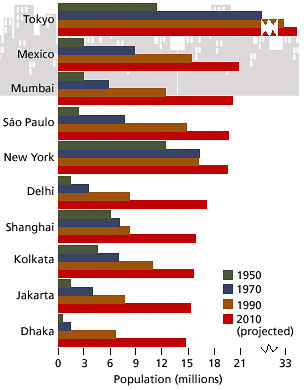Much of today's environmental impacts originate in cities
 The world has seen a dramatic shift to urban living. In 1900, only 10 per cent of the global population were urban dwellers; now it's more than 50 per cent. More than 95 per cent of the net increase in global population will be in cities in the developing world
The world has seen a dramatic shift to urban living. In 1900, only 10 per cent of the global population were urban dwellers; now it's more than 50 per cent. More than 95 per cent of the net increase in global population will be in cities in the developing world Cities are both drivers of and responders to environmental changes in rapidly developing countries like China and India. Unprecedented growth in urban population over the past century has occurred in less than 3 per cent of the global terrestrial surface. But their impact has been global, with 78 per cent of carbon emissions, 60 per cent of residential water use and 76 per cent of wood used for industrial purposes
Cities are both drivers of and responders to environmental changes in rapidly developing countries like China and India. Unprecedented growth in urban population over the past century has occurred in less than 3 per cent of the global terrestrial surface. But their impact has been global, with 78 per cent of carbon emissions, 60 per cent of residential water use and 76 per cent of wood used for industrial purposes
 |
| Change in population of the 10 largest urban centres from 1950 to 2010 (projected) |
 Perceived opportunities in growing urban centres and lack of opportunities in rural settings resulting from degraded landscapes and economic imbalances have triggered migrations since 1950 and the trend continues.The concentration of transportation and industry in urban centres means that cities are sources greenhouse gases that cause climate change
Perceived opportunities in growing urban centres and lack of opportunities in rural settings resulting from degraded landscapes and economic imbalances have triggered migrations since 1950 and the trend continues.The concentration of transportation and industry in urban centres means that cities are sources greenhouse gases that cause climate change In the past two decades, there has been large increase in the output of materials such as the food-waste and solid waste accumulation and growth in demand for building materials
In the past two decades, there has been large increase in the output of materials such as the food-waste and solid waste accumulation and growth in demand for building materials  Cities show symptoms of the biogeochemical imbalances that they help create at harsher scales.For example, cities experience high acid and high concentrations of atmospheric CO2, CH4 and O3
Cities show symptoms of the biogeochemical imbalances that they help create at harsher scales.For example, cities experience high acid and high concentrations of atmospheric CO2, CH4 and O3 City centres are physically hotter.Known as the heat island effect, urban and suburban temperatures are 1
City centres are physically hotter.Known as the heat island effect, urban and suburban temperatures are 1





